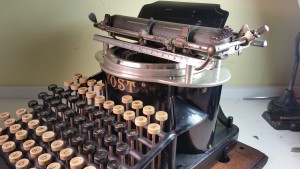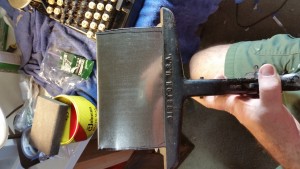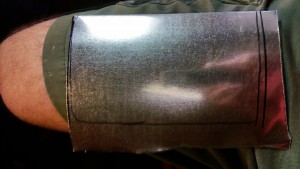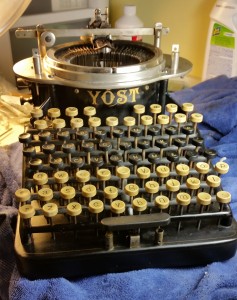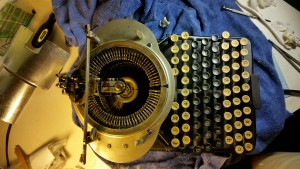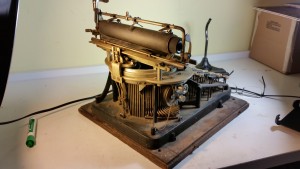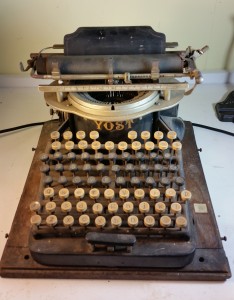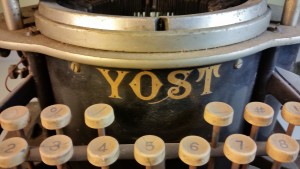Yost, Model 4 (Cira 1895)
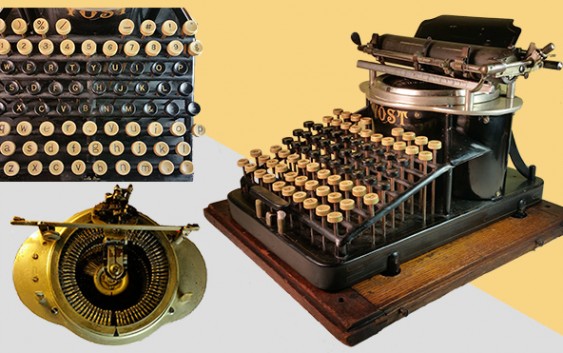
Put Yourself In Yost’s Place
Imagine it is the mid 1800’s and you want to create a portable printing press. Something that can be easily moved, self-contained and did not require a skilled typesetter to use. In short, you want to create a typewriter. How would you solve the various challenges of converting a manual process into a mechanized 19th century wonder?
Let’s start with our only reference, the printing press.
I am not an expert in printing presses, but from my layman’s perspective you set the type (pieces with physical letters, numbers, etc.), ink the typeset, and lay on a piece of paper and press evenly down to transfer the ink from type to paper.
Slide Show:
Challenge 1: Select the type characters.
So, my first challenge would be getting all the physical type pieces into one place. Easy enough.
- 26 letters in the alphabet
- 1 – 9 (I can reuse the “O” as a zero)
- 17 punctuation and symbols
That is a total of 52 pieces of type.
But wait, what if I want to do upper and lower case characters? Nuts. Let me throw on another 26 upper case characters to go with the lower case for a grand total of:
78 Type Characters!
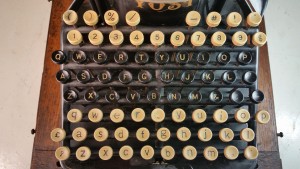
Challenge 2: Arrange the typeset.
If we lay 78 characters out like a manual typewriter from the 20th century the thing would be 3 feet long. How can we arrange so many characters in a way that minimizes space, but can reach a central point for ink transfer? A circle! Brilliant. I will run each of the 78 pieces of type to a key. When pressed the key will push the piece of type to the center.
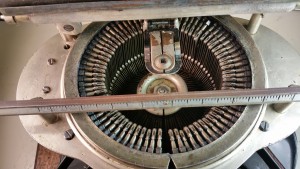
Challenge 3: Printing presses print from the bottom onto a flat surface.
Ok, I need the type to come to the center, then move up and strike something that is capable of advancing the paper. Being in the printing business, the characters must fall exactly in the same place! No floating or misaligned characters. After all, we are professionals. Solution:
- Grasshopper movement – Let’s have the type come from the outside to the center then move up. The movement and look very closely mimics a grasshopper leg and you have to wonder if Yost did not directly lift this design from Mother Nature.
- Faceted platen – We can have a round cylinder with flat ridges. The cylinder can be rotated to advance the paper and the flat ridges will allow the type to strike evenly. Looking into the future, the Yost 4 has a cylinder that is hollow allowing for a completely round cylinder.
Question: So looking back, what is the one drawback of this design?
Answer: You can’t see what is typed! You are literally typing on the bottom of the roller!
- Accuracy – Yost was particularly concerned with alignments. So much so, a disc with a rectangular hole was mounted in a fork. In order for the type to come in contact with the platen, the rectangular type had to exactly fit the rectangular hole. It was either a perfect strike or nothing! This is one instance where many future manual typewriters did not exceed the past. For those of us old enough to remember manual typewriters, we recall that there were a few characters that hit a little high or low on contemporary manuals. Many a crime novel included clues such as a type written ransom note where a character was slightly off and was able to be tied back to a misalignment on a particular typewriter owned by the butler. If only he had used a 1895 Yost!
- Ink – Ok, on a printing press you ink the type… Got it! I will make an ink pot (felt pad) that the type can rest in. When the type moves from the ink pot, it will be ready to print.
And after a 100+ years, the ink pot will leave one heck of a mess on the type that some poor sole will spend hours trying to clean. Eventually this person will resort to using a water hose and degreaser and vent angrily in an online post.
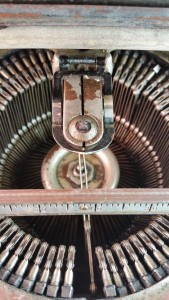
Challenge 4: Platen Movement
Oddly enough, this seems to be something consistent amongst all the manual typewriters. Put the platen on a guide and attach a cable to a wound spring. When you press a key, use a tooth guide to allow the platen to be pulled one “character” over. I greatly simplified a beautiful and complex process, but this is the age of the Industrial Revolution, so we have springs and pulleys well in hand!
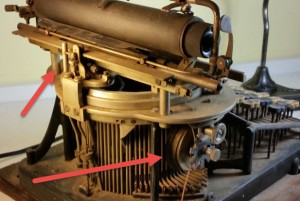
In Summary
What I love about my Yost Model 4 is the simplicity of concept and the complexity of execution. Truly this machine is a wonder of a bygone era where problems required mechanical solutions. I will now perform one last spell check. Copy this post from my word processor to my WordPress site. Adjust the font. Upload the images. And just be a tad melancholy that it was all so easy.
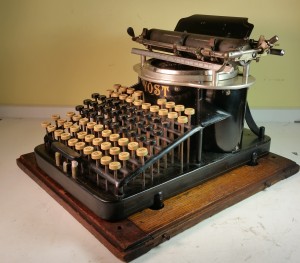
Abbreviated History:
Attributed Inventor: George W.N. Yost
Company: Yost Writing Machine Company, Bridgeport, USA
Model: Yost 4
First year of production: 1895
Serial number: 53750
Additional Sites:
Great site for general history!
Absolute must read on the restoration of a Yost 10!
Additional Photos:
